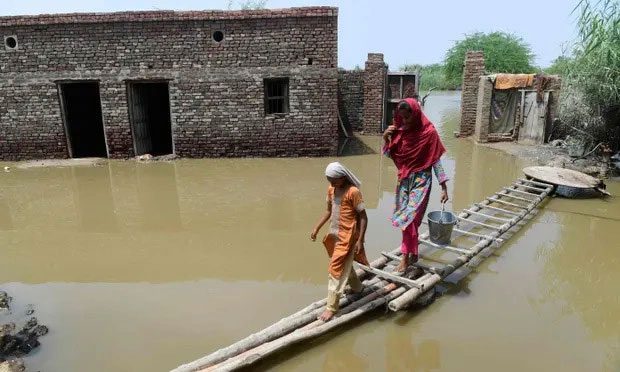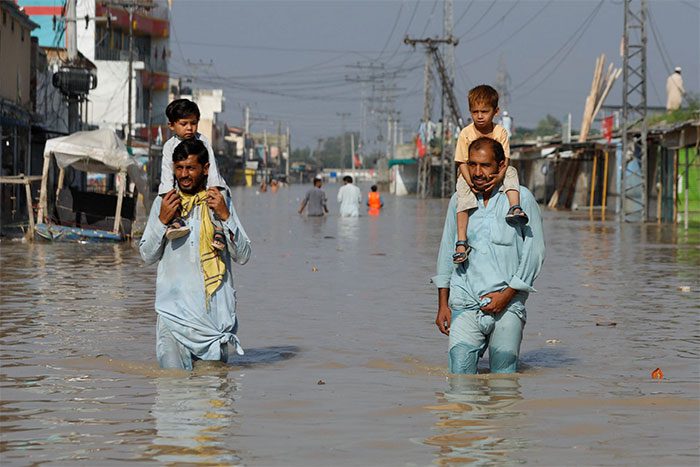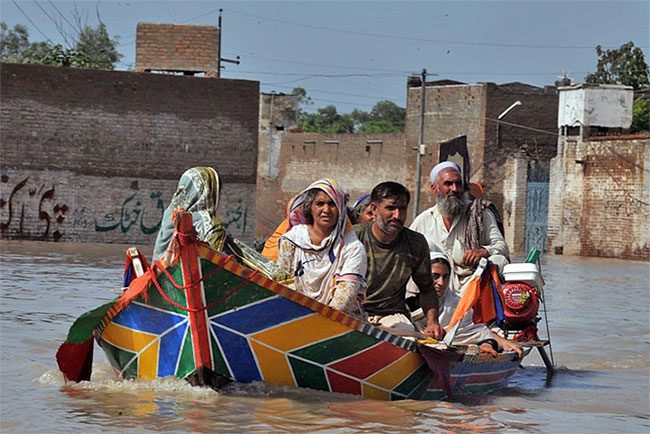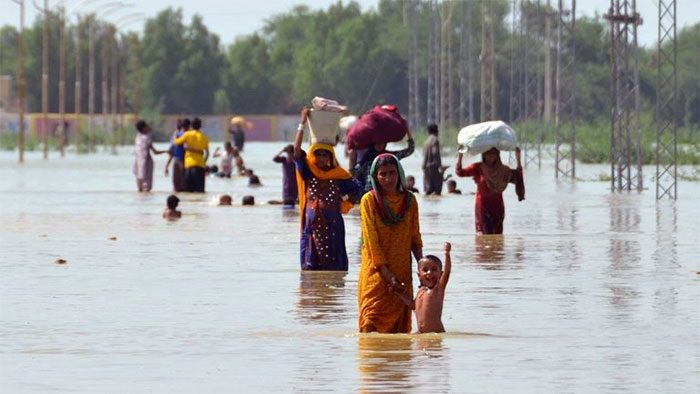The impact of climate change, along with several other factors, is believed to have led to an unprecedented flooding disaster in Pakistan, according to The Guardian.
Initially, climate change was considered the primary cause of the severe floods across Pakistan. To date, these floods have claimed the lives of 1,136 people and affected the lives of 33 million others.
However, the causes of this historic flood are believed to be much more complex, involving various factors such as Pakistan’s mountainous terrain, the deterioration of the dike system, climate changes, and the lack of preparedness among the impoverished population of Pakistan to cope with large-scale natural disasters.
“We are witnessing the largest flood in Pakistan’s history,” said Dr. Fahad Saeed, a climate scientist at the Climate Research Organization in Islamabad.

A temporary walkway constructed in Shikarpur city, Sindh province. Continuous heavy rainfall has caused flooding in nearly all areas of Pakistan. Photo: AFP.
The primary cause of the flooding is the record-breaking rainfall.
Continuous Rainfall
“Pakistan has never recorded rainfall with such continuous frequency as it is now. After 8 weeks, heavy rains have left much of the country facing flooding. The heavy rains are causing severe consequences across the nation,” said Sherry Rehman, Pakistan’s Minister of Climate Change.
Since early August, the rainfall recorded in Sindh province has been nine times higher than in previous years. Nationwide, the rainfall measured over the past month is also five times higher than the same period in previous years.
Scientists are trying to determine the significance of global warming in causing floods in Pakistan. In the last major flood in Pakistan in 2010, climate change was considered one of the main causes.

The flooding has affected the lives of over 30 million people in Pakistan. (Photo: AFP).
According to a study in 2021, global warming is making the monsoon season in South Asia increasingly severe and erratic. Rainfall in the region increases by 5% for every 1°C rise in average global temperatures.
Pakistan has been frequently subjected to floods since 2010, alongside wildfires and prolonged heatwaves.
“We are severely affected by climate change. We are no longer surprised to endure disasters annually,” Saeed shared.
According to Liz Stephens, a professor of risk and resilience to climate change at the University of Reading and a member of the international flood warning system, the ongoing flood in Pakistan is predicted to occur only once every century.
“The severe flooding is happening across the nation. In many areas, the situation will be worse than in 2010, when floods claimed the lives of 1,700 people,” Stephens stated.
Complex Factors
Stephens noted that the two main causes of significant human loss in the current floods in Pakistan are flash floods and the deterioration of the dike system.
She explained that in many areas, flash floods occurred after rainwater flowed down mountainous terrains, increasing the speed of floodwaters. Additionally, in some regions, deforestation has removed natural barriers that prevent flooding.

The current flooding in Pakistan is considered worse than the historic flood the country experienced in 2010. (Photo: The New Humanitarian).
“It is very difficult to predict and evacuate people during flash floods,” Stephens remarked.
In many areas, river dike systems have also been damaged.
“You cannot predict when the river dike systems will be destroyed. Many people living in dike areas and believing they are protected are not adequately prepared when floods occur,” she analyzed.
According to meteorologist Scott Duncan, another contributing factor to the historic floods in Pakistan is the El Niño-Southern Oscillation (ENSO) phenomenon. He noted that the current ENSO phenomenon is in a La Niña phase, similar to the period during the major floods in Pakistan in 2010.
“In my opinion, during the La Niña phase, ENSO can have powerful effects and may be a leading cause of making the monsoon season more severe,” Duncan remarked.
Vulnerable Populations
The people of Pakistan are highly vulnerable to extreme weather events caused by climate change, ranking 8th among the countries affected by this issue according to the Global Climate Risk Index.
“Pakistan is very vulnerable to consecutive extreme weather events. Prolonged heatwaves from March to May, followed by the monsoon season causing flooding across the country, have severely impacted the economy and the lives of the people in this South Asian nation,” Duncan stated.
He also noted that global warming has increased the risk of prolonged heatwaves, like those experienced last summer, by 30 times.

Pakistan is one of the most vulnerable countries to climate change. (Photo: AP).
“Poverty, malnutrition, disease, what people see today will be what Pakistan faces in the future if we do not seriously respond to climate change,” said development and climate expert Ali Tauqeer Sheikh.
“Fortunately, the monsoon season in Pakistan is nearing its end, and the region will not have to endure heavy rainfall in the coming days,” said Nicholas Lee, a staff member of the MetDesk weather forecasting service.
However, it is evident that climate change significantly impacts the increasing frequency of natural disasters and extreme weather events, even though the average global temperature has only risen by 1.1°C since pre-industrial times. Pakistan is the latest country to suffer severe human and material losses due to this situation.
“The world is on high alert,” Rehman warned.


















































